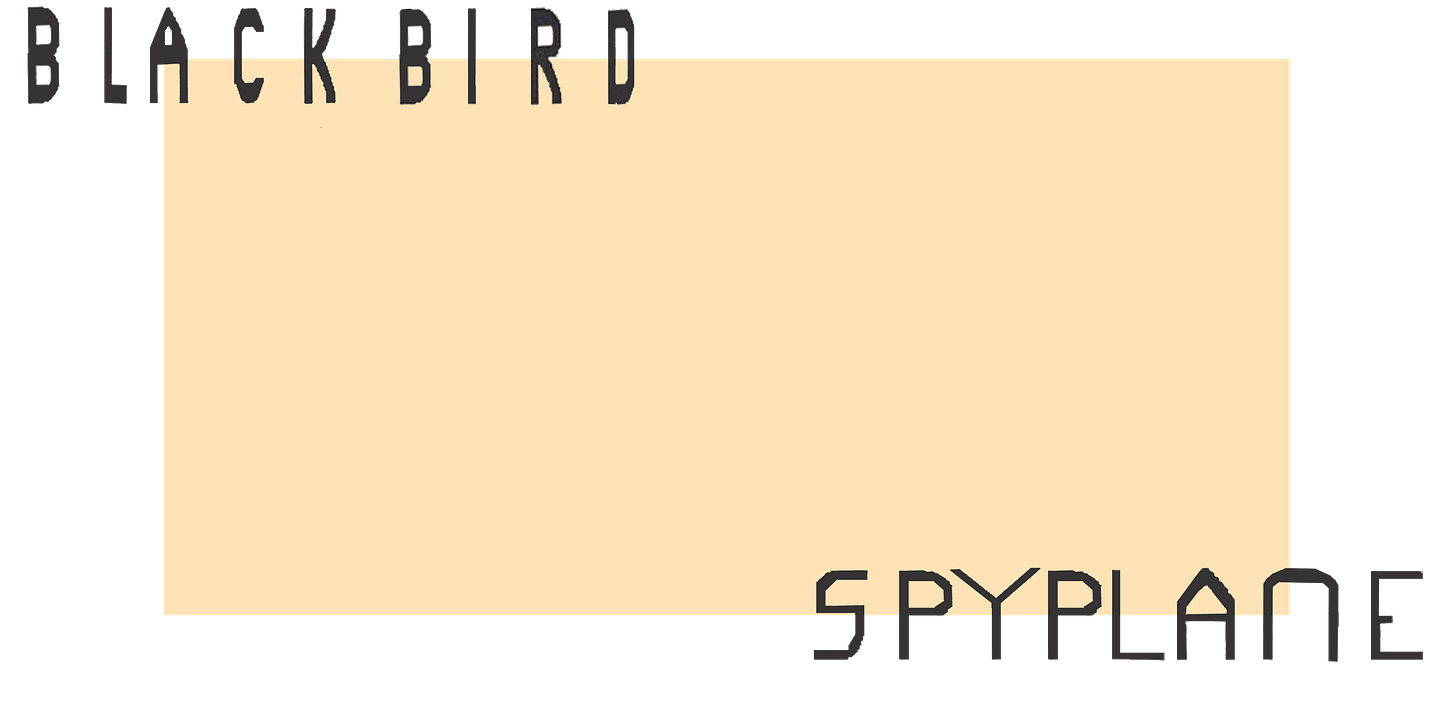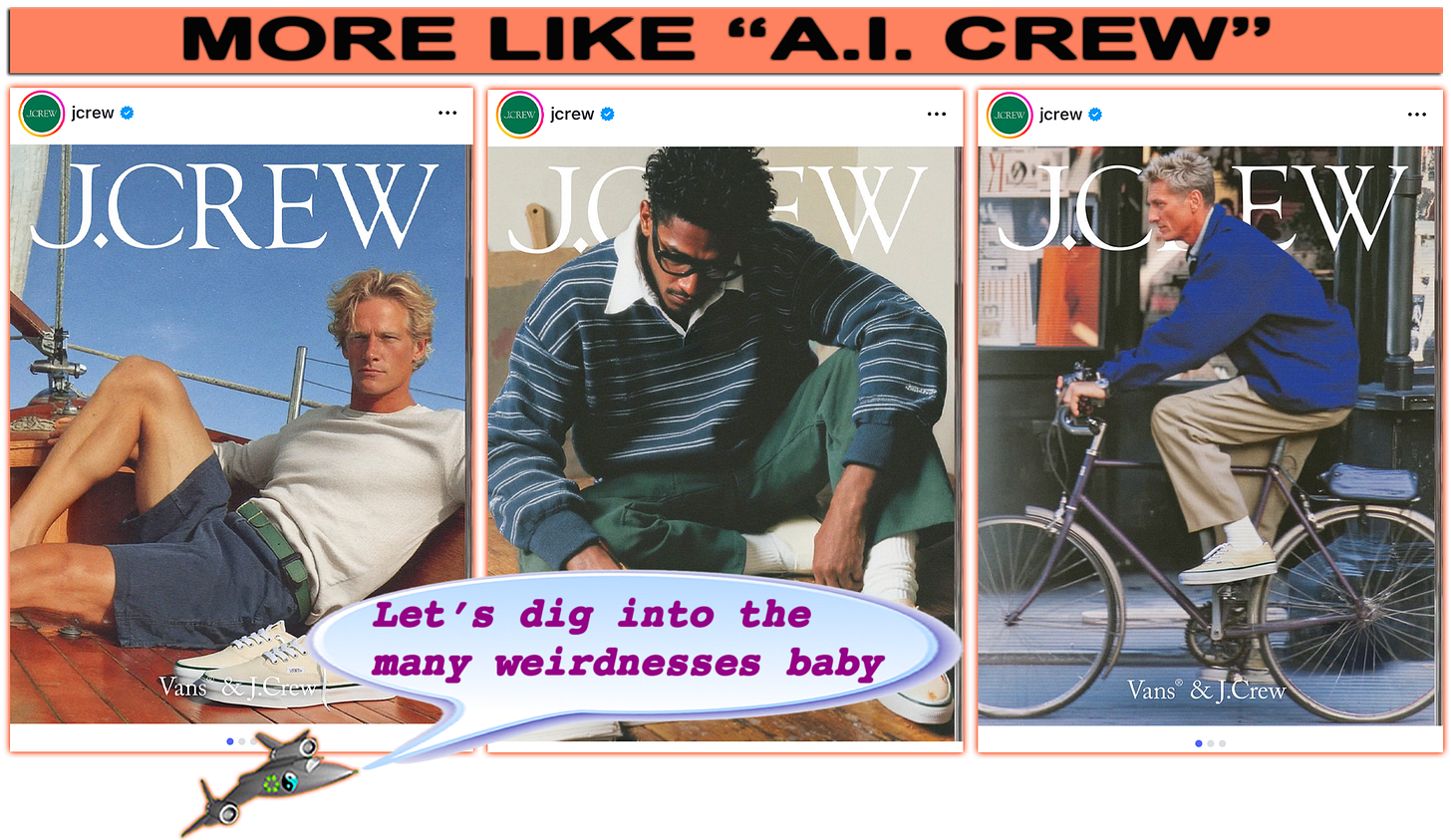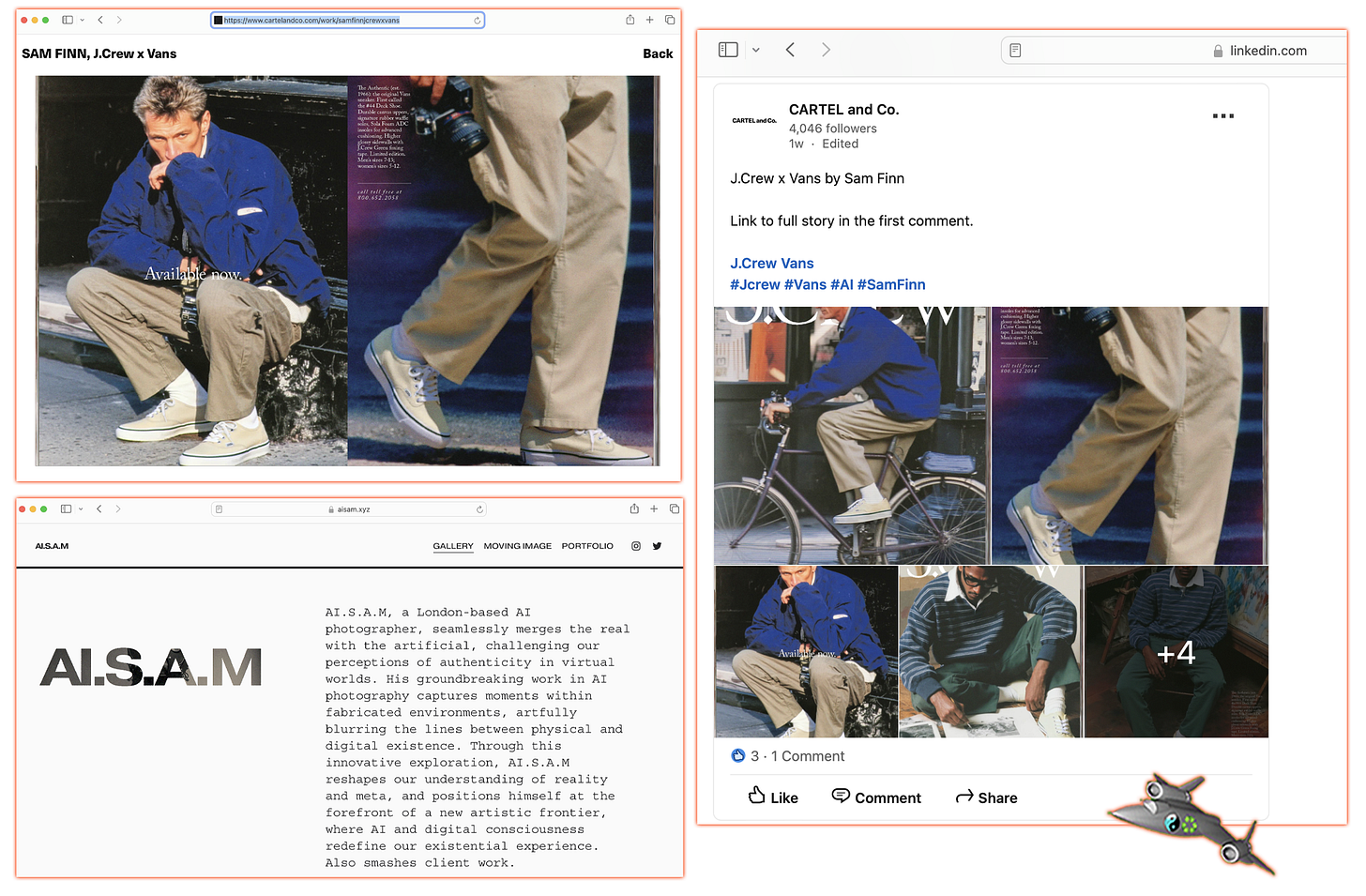J.Crew used A.I. to counterfeit their own vibes
Why? An Exclusive Spyplane Investigation
Our interviews with Nathan Fielder, Brendan from Turnstile, Adam Sandler, Issy Wood, Andrew Kuo, MJ Lenderman, Kim Gordon, Steven Yeun, Maya Hawke, Bon Iver, André 3000, 100 gecs, Matty Matheson, Laraaji, Eckhaus Latta, Mike Mills, Tyler, The Creator, John C. Reilly, Rashida Jones, Camiel Fortgens, Father John Misty, Kate Berlant, Clairo, Conner O’Malley and more are here.
Mach 3+ city intel for traveling the entire planet is here.
Check out rugs, cushions, lamps, ceramics and more in our Home Goods Index.
Here at Blackbird Spyplane, we don’t just celebrate great clothes and explore the secrets of sauce semiotics. We also scan developments in the culture at large for signs of Where We Are Swagwise as a Society.
Case in point? They don’t say it anywhere, and no one else has reported on this, but these “classic,” throwback-vibed images J.Crew posted to Instagram the other day were, in fact, A.I. generated:
Erin and I are longtime, on-the-record vintage J.Crew appreciators. So when these got shared into my timeline earlier this month, I was intrigued. They’re styled to resemble J.Crew’s catalog imagery from its late ‘80s and early ‘90s heyday — an aesthetic that’s been mined and enshrined over the past few years on moodboard accounts like Lost J.Crew and the excellent Simplicity Man, which regularly post J.Crew swipe from that era.
I should clarify that I was intrigued, but not so intrigued that I didn’t do what I imagine most people did, especially people who saw these images on their phones, which was glance at them for a couple seconds, take note of the circa-1987 energies, and then keep it pressing.
But this past weekend, a well-placed Spyfriend tipped me off that, according to someone else with knowledge of the images’ creation, they were made using A.I.
I gave the posts a closer look, and asked a couple other eagle-eyed, photo-savvy Spyfriends to do the same. One enlisted her boat-fluent dad. And damn it if we didn’t turn up a bunch of telltale glitches and weirdnesses.
Up top, the model lounging in the boat and dockside seems to change from the first slide to the second, but his outfit stays the same, except for a mark that materializes on his chest. The shadow on the underside of his leg looks funky.
The Spyfriend’s dad who knows about sailing also noted, of the “lifelines (what he’s leaning on) — that kind of configuration is usually in the bow — but they should go all the way to the end of the bow. That gap left behind is where you don’t want people falling through.” (He had a lot of other nautical red flags.)
Meanwhile, in the main pic of dude in glasses sketching, his tucked right foot appears to be bending backward underneath him at a 90-degree angle. Like, somehow we’re looking at the heel of the shoe? Either that or the shoe has morphed into a laceless slip-on.
The stripes on his shirt are glitchy in the first slide, then crispy in the second — where his placket rests in a strangely pinched way, as if Camiel Fortgens intentionally designed the shirt all f--ked up. Also, if you look at his shoes, there’s a paint splatter-mark on his left shoe that is lower in one picture (above left, where the eyelets, incidentally, seem to sit atop the shoelaces) than it does in another (above right).
The other post has its own head-scratchers, including weird handlebars on the bike; an inexplicable bright spot on dude’s left sleeve that isn’t there in the other pic; and a truly bizarre looking camera:
There are other funky inconsistencies across all these pictures (e.g., look closely at the bike pedals), and probably some more I missed, which you might find.
J.Crew does not acknowledge in the captions that these images are A.I.-generated or -manipulated. They didn’t acknowledge it when a few commenters called out A.I. telltales. When one person asked for an ID on the striped rugby, saying, “can’t find it in the site,” the J.Crew account did reply, “this is a vintage style.” Is it, though??
After further sleuthing, I identified the creator of these images. He’s a self-described “AI photographer” called Sam Finn, who also goes by the name “AI.S.A.M.”
J.Crew didn’t credit Finn anywhere that I could find. This “shoot” isn’t included on the portfolio section of his site, nor on his IG. But Finn’s agency does credit him with the images, both on its site and on its LinkedIn.
Unlike J.Crew, the agency hashtags the images #AI, too:
Finn’s other work is full of discomfiting, sci-fi-inflected imagery, like a mutant girl grinning at a convenience store, a deer undergoing medical tests, and riot cops with dogs’ heads. According to a 2023 interview, Finn’s picture-making m.o., “simply put,” is that he fires up Midjourney, “describes what he wants to see and the AI creates the image.” In a more recent IG comment, he talks about using Midjourney, ComfyUI and Stable Diffusion to create a carousel of 7 images that he calls “all AI.”
For a disorienting moment, I wondered if the term “AI photographer” meant that Finn is himself a creation of A.I., and while I haven’t ruled that possibility out entirely, I do think he is a real person.
But I should call Finn the most proximate creator of these images, because I don’t know who else’s creations were or weren’t fed into the generative AI tools Finn uses. That is, of course, one of the main differences between generative A.I. and other creative tools: it depends on a vast dataset of other people’s pre-existing work.
A bio on Finn’s site tells us that he “seamlessly merges the real with the artificial,” and that his “work in AI photography captures moments within fabricated environments, artfully blurring the lines between physical and digital existence.” Presumably the shoes featured in these images — the Vans collab J.Crew is promoting — are real, meaning they were actually photographed and inserted into A.I. tableaux. But what about the models, their clothes, and their environs?
I noticed that the composition of the on-bicycle shot, for instance, is near-identical to that of an actual Spring 1998 catalog cover. The bikes themselves are very similar, too. Was the old picture an inspiration, or did Finn actively feed it into Midjourney or what have you?
I sent Finn a few questions on Sunday evening, asking him to shed some light on how he made these images, but he has yet to reply. As for J.Crew, I’m not sure what they got out of this approach vs. a traditional shoot, besides a group of ostensibly cheaper images that are subtly but palpably wrong.
Is this their first A.I.-generated campaign? Which elements of the images, if any, are real? And why didn’t they label the images as A.I.? I sent these questions to a P.R. rep at the company yesterday morning, and haven’t heard back. We’ll update this post if we do.
In the meantime, I have a theory as to why J.Crew chose not to credit Finn and tag these pictures as A.I.-generated.
Because the whole thing feels creepy. Not just in the run-of-the-mill uncanny undead A.I.-slop sense, but also thanks to the specific content of these images.
Two of them portray artists. There’s the painter, sketching and reclining before easels at his studio, paint on his shoes from the physical art he has supposedly been physically making. And there’s the bike-riding street photographer, who is doubtless meant to invoke the legendary Bill Cunningham. Cunningham was, of course, a true Real One, known for pedaling around Manhattan in a blue work jacket and chinos for decades, taking real pictures in real time of real people wearing real clothes in real places.
The implication of using A.I. to create these two “artists” is that generative creation tools are not only eating but swagger-jacking and cloning their flesh-and-blood human equivalents. It reminds me of that Apple ad people hated last year where a giant hydraulic press violently destroys a collection of beautiful musical instruments and artmaking supplies and transforms them into a cold, lifeless iPad. (Apple apologized.) I would much prefer that actual photographers get money to shoot actual pictures than outsource that work to AI-image-generating platforms, even if there are human operators feeding in prompts.
The funny thing is, the A.I. approach doesn’t even work here on J.Crew’s own terms, because the resulting images are fundamentally at cross-purposes with the fantasy J.Crew hopes to channel. Their classic catalogs, after all, set in leisurely blueblood milieus, were textbook “aspirational.” A lingering, nostalgic sense of glamour tinges our collective memory of those catalogs, which is why J.Crew brought back its physical catalog last fall, and why they’ve recently reissued things like a baseball cap, originally released in 1998, with a proto-Y2K “jcrew.com” URL embroidered across the front.
But when you realize that the seemingly rarefied locales and energies depicted in these new pictures are in fact replicas, assembled by a computer that seems to have scraped all those old catalogs and counterfeited their vibes, then that kills the aspirational fantasy.
It’s A.I. aura-cannibalism. We aren’t seeing some beautiful place we’d like to be, full of beautiful people chilling. We’re seeing the cursed daydreams of a server farm.
P⚓E⚓A⚓C⚓E until next time,
— J & E
UPDATES: 11:00 a.m. PT Aug 26. J. Crew just edited the captions of the three posts, which still don’t mention AI but now credit Finn with the “digital art.”
1:30 p.m. ET. A spokesman for J.Crew has passed along a response from the company, which doesn’t answer any of the specific questions I sent, but attests that they are “always exploring new forms of creative expression,” and cites Finn’s AI-generated posts as an example “of how we engage artists of all genres to interpret our brand and experiment with different art mediums.”
The B.L.I.S.S. List — a handy rundown of Beautiful Life-Improving Spyplane Staples, from natural deodorant to socks and underwear — is here.
Our new guide to How To Pack for a Trip Swaggily is here.
Classified-Tier Spyfriends request, share and receive Mach 3+ recommendations in our SpyTalk Chat Room.









Yeah this sucks lol. I haven't seen a single thing that AI or AI "artists" have made that wouldn't be objectively better if made by a person. Not to mention that rather than pay actual artists and models for their craft they chose to do some weird generated shit that not only reduces their entire aesthetic to an algorithm but also harmed the environment at the same time. It honestly made me think about whether I want to purchase anything from J.Crew now.
Hello, bicycle nut here.
Up first, I would simply love to see real humans on real bicycles or posing on real boats in real clothes trying to approximate the vibes of those old J. Crew catalogs... instead of the slop. Not that I'm hungry for them to historically reenact their old catalogs and product lines, more that we'd be having a much more fun conversation about how they did or didn't nail it and we could critique all the real life choices that go into a project like that. Instead we're lamenting how dispiriting and lame these images are.
Physics betray the possibility this bike could be in motion. Only digital nightmare logic gets us there.
Zoom in on the tires and you'll notice they're almost bottoming out on the rims. Tires that flat would be functionally unrideable.
The crank is completely wack. The crank arms should be inline with one another, like the hour and minute hands when it's 6:00 on the dot. In the AI image the non-drive side (left) crank is at 12:00 and the drive side (right) crank is at 4:30. Non drive side pedal would be centered on the crank spindle as well, not the case here. The foot placement is even more center-of-gravity-defying.
The bicycle appears to have only a fragment of chain: just a short lateral section floating between the chainring and halfway to the cassette. Chain does not continue to wrap back around the crank. The chain is not inline with the rear axle, heading towards the nonexistent cassette.
The chainrings themselves look extremely wack and there's a Conestoga wagon wheel's worth of spindles packed in there... never seen anything like it.
I wouldn't go so hard on "identical composition," here. We have two images of non drive side profiles of a cyclist and bike in motion. The OG catalog models are doing some tricky maneuvers, rider up front has left leg fully extended, standing on the pedals, straddling the top tube, maintaining the balance of the seated passenger. All made a lot easier by the very high handlebars. Don't get me wrong, they're having a blast.
AI rider is seated in a rather convincing relaxed riding posture, though the seatpost suggests the saddle is unusually long.
Man, the fender lines on the front wheel of the AI bicycle are crazy realistic. Looks like a very human, uneven gap between the plastic fender and the tire. But then the fender itself torques and the stripe detail along the edge twists away unconvincingly, melting into cyberspace. The spokes and lacing on both wheels are very weird.
Stem and bars: This is perhaps a digital regurgitation confused by the shape of drop handlebars and a miscalculation of how stems and handlebars interface in the tangible world.
Okay, peace out. Physicists and mechanics, please delight me and let me know if there are other issues you've observed here.